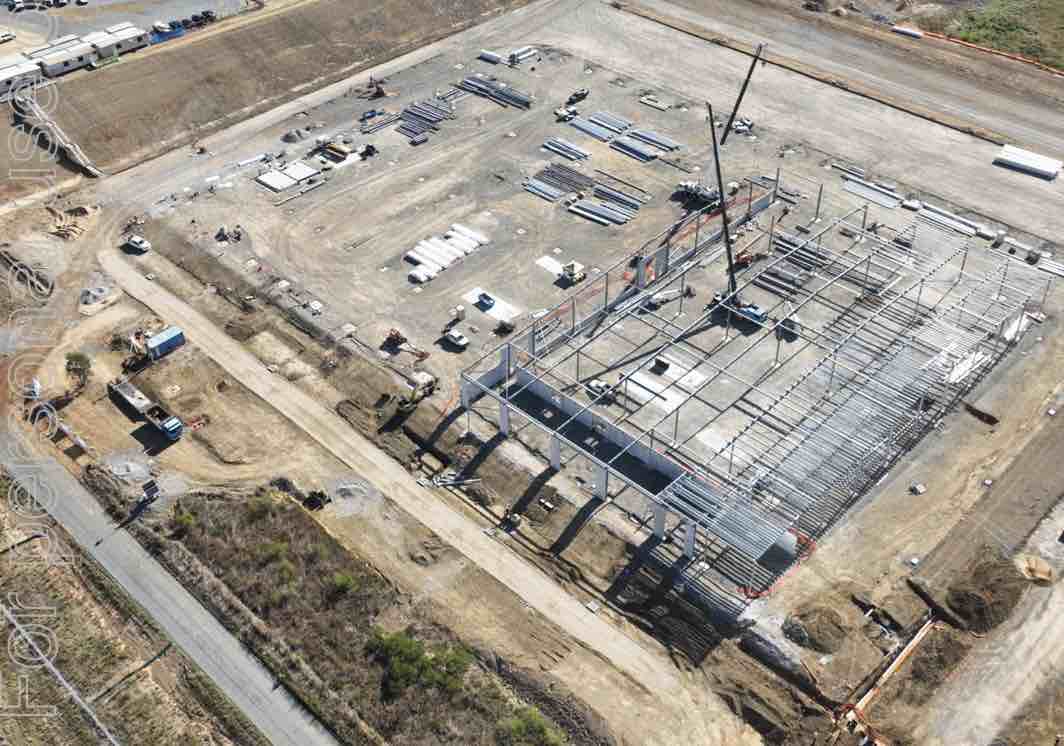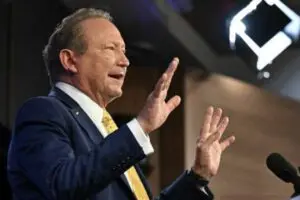Iron ore billionaire and green energy evangelist Andrew Forrest says “energy must change” and has insisted his plans to deliver 15 million tonnes of green hydrogen a year by 2030 still stand, even though the company is yet to fill in the details of how exactly that will be done.
At a briefing for the company’s annual results, which delivered a $US6 billion net profit in fiscal 2021/22 and a $A2.3 billion dividend to Forrest himself, the now executive chairman of Fortescue Metals says his vision of a green energy future, including renewables and green steel, is undiminished.
“Fortescue can and will lead the green energy revolution,” Forrest said. “Energy must change. We have no choice. I mean, if you’re advocating for anything else, then you’re either economically or scientifically ignorant, or both.
He later added: “We chop through, like all the others, a few billion dollars a year in fossil fuels. We literally smoke it. It will be a great day, and I think it’s serious revenue and margin improving day, when we can make all our own fuels.”
Forrest told analysts that informal discussions with global funds managers indicated a potential value of $US20 billion ($A29 billion) for its Fortescue Future Industries offshoot, which is leading the company’s charge into green energy.
That, of course, is a notional valuation, and Forrest says he currently has no intention of separately listing the subsidiary.
But it underlines what he says is the massive global interest in the green energy switch, and in who ends up leading that transition, and how a heavy industry can cut emissions and costs and by not smoking “billions of dollars” in fossil fuels each year.
Forrest and his team have been touring the world striking agreements with customers and suppliers, including a massive MoU with Germany’s E.ON for five million tonnes of green hydrogen, and unveiled numerous plans in Australia for manufacturing of electrolysers, renewable energy production and industrial deals.
The team employed by Fortescue Future Industries has now grown to more than 1,100, and has a budget of more than $1 billion for the current financial year, including much of the $110 million to be spent on what is hailed as the world’s biggest hydrogen electrolyser plans in Gladstone.
But the market is waiting to see which of the multitude of supply deals translate into signed agreements, which of its many Australian projects actually get built, and how Fortescue overcomes the cost challenge of exporting green hydrogen to European and Asia customers.
Mark Hutchinson, the new CEO of FFI who made his first public appearance at the media and analyst briefings, says he expects many announcements to be made over the coming months in what he expects to be a “multi-trillion dollar” market for green hydrogen.
“We have plenty of projects to choose from,” he said, adding that he also saw huge demand, and expected to announce more customer deals similar to that with E.ON.
Hutchinson compared the green hydrogen industry to the launch of the current global oil giants Shell and bp in the early 1990s. “We are at that inflection point,” said the former head of GE in Europe, who took up his position at FFI a few weeks ago.
“We are kind of replacing the entire fossil fuel network globally …. we’ve got a tonne of stuff to do. This is just the start.”
On Fortescue’s own operations, that process has started at small scale – at least in comparison to the estimated 400GW of new renewables that might be needed to deliver on its green hydrogen plans.
A 60MW solar farm in the Pilbara has helped eliminate 78 million litres of diesel in the past year, and new solar farms and a big battery will be built not a new transmission line to its Iron Bridge iron ore project has been completed.
It is also working on innovative projects such as the so called “infinity trains”, using gravity and rechargeable batteries to power the massive trains delivering iron ore to the ports in the Pilbara, it is electrifying its trucking fleet and is considering pumped hydro as a storage option, thanks to the elevation of the mining sites.
A 5.4GW wind and solar project in the Pilbara is also contemplated, and even bigger but as yet undefined projects further south in Western Australia, where Fortescue is reportedly signing deals with farmers to host large wind farms and is also searching for port facilities.
Hutchinson says the push to green hydrogen is being accelerated by geo-political events such as Russia’s invasion of Ukraine and the gas crisis in Europe, and the new US “inflation reduction bill” which he says has made green hydrogen competitive with fossil fuel hydrogen.
He says FFI’s focus is on green hydrogen production projects in Australia – including in Queensland, Tasmania and western Australia, but he also warned that Australia and Europe may need to follow the US plan to offer tax credits to green hydrogen production or risk missing out on investment.
“I think countries around the world have got a look at what the US is doing,” he said. “Europe really has to take notice of what the US has done and they they have to they need it probably more than anybody else.
“If they don’t do something similar, then what’s going to happen is that all the funds are going to go to America rather than Europe, which would be a real shame.”
The big question for many analysts and market observers is the cost of transport of green hydrogen. If Fortescue signs massive deals for the supply of green hydrogen to Europe, and wants to produce that in Australia, then how can that be economically done. Shipping of green hydrogen is considered to be the technology’s weak link.
In response to a question from RenewEconomy, Hutchinson said the options were to ship the hydrogen as green ammonia, or green methane.
“We’re looking at all the different ways to get it at the best possible cost to our customers in Europe. So that work’s ongoing. It’s going to be very much driven also by the customers and what they want.”
However, in the later analyst briefing, Hutchinson said that some renewable supply projects could be built in Europe, closer to demand, at least in the initial stages.
“We see that there’s going to be great demand for green hydrogen from around the world, including Asia … so Australia will play a big part in that,” he said.
“I think the the only issue in Europe is that it’s more challenged on you know, producing the green energy at scale, that probably Australia can. So initially, I think maybe some of the projects will be in Europe. But given scale of what needs to happen, this is a massive opportunity for Australia.”
Hutchinson says the new electrolyser manufacturing facility in Gladstone is progressing well (see photo above), and should be producing electroliers in 2023, at a rate of up to 2GW a year, which would make it the biggest in the world.
He confirmed Plug Power technology would be used initially, as per the original deal (curiously Plug Power did not mention this project in its most recent briefing), but FFI will also be looking at other technology providers.
(Note: This story has been updated to reflect that $20 billion figure cited by Forrest is $US).










